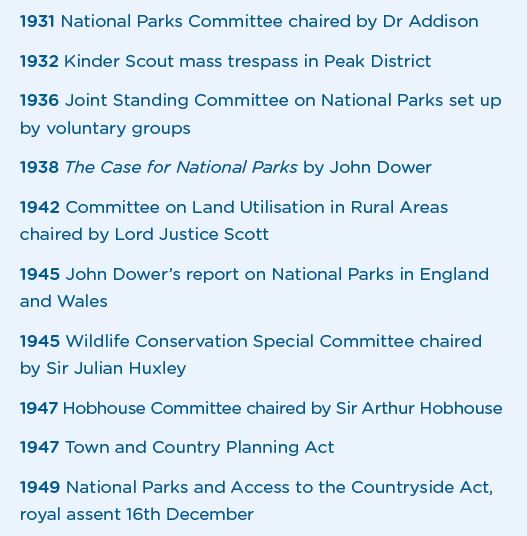The long road to the 1949 Act
9 April 2019
Campaign for National Parks trustee, Anne Robinson shares the story of the campaigns and politics that brought the National Parks into existence.
The milestones on the long road to the momentous legislation which enabled designation of National Parks and Areas of Outstanding Natural Beauty are well rehearsed but the public spirit that fought for decades to realise the protection of our most beautiful landscapes sometimes gets lost.
Before the movement began to cohere into an identifiable campaign in the 1920s it was preceded by half a century of disparate activity on several fronts by many groups. Attitudes towards mankind’s treatment of the natural world were changing. People were angry about the disfigurement of the countryside and the lack of access to it. They not only wanted to preserve wilder landscapes but also to see them, get into them, and enjoy them.

South Downs. Photo Credit: Ben Ellis
New societies sprang up to serve these aims. The Commons Preservation Society (now the Open Spaces Society) was founded in 1865 to halt further enclosure of commons, and later to protect public paths. Unable to buy land to protect it from development, the Society set up the National Trust in 1895 to preserve beautiful land and buildings permanently. There were also an increasing number of local footpath societies and rambling clubs in the Edwardian years. But in the 1920s public appreciation of natural beauty and a growing desire to enjoy the countryside both by car and on foot clashed with the ugly realities of urban sprawl, quarries, pylons, reservoirs, and brash outdoor advertising. Mounting concern over these issues could not be contained within the existing amenity societies, and to counter these unplanned threats the Council for the Preservation of Rural England was formed in 1926.
Reserving parts of the countryside for amenity and recreation now had a sense of urgency. The first opportunity for progress came with Dr Addison’s National Park Committee in 1929 but its recommendations were fobbed off by an unreceptive government relying on the feeble Town and Country Planning Act 1932.

That same year those denied freedom to roam on the moors staged their biggest trespass, on Kinder Scout. Such provocative tactics conducted by the working classes were anathema to both the timid Ramblers and the legalistic Opens Spaces Society, who would have nothing to do with Benny Rothman and the other trespassers, but they did bring a sharp political edge of activism.
Nevertheless, the impact of all this activity remained limited. In a surge of frustration a large conference met in 1935 in Westminster Hall. The cause attracted people with strong campaigning skills — legal expertise, professional and academic knowledge of nature conservation, landscape, architecture, and town planning, often combined with a passion for social justice. Together they inspired a movement which became eventually the Campaign for National Parks but in 1936 was called the Standing Committee on National Parks.
Chaired by Sir Norman Birkett KC, this became a persistent and cogent advocate for the Parks. Hard-edged lobbying of decision-makers was coupled with an idealistic and emotional appeal to the public. A pamphlet The Case for National Parks was circulated, a photographic exhibition toured the country, a film about National Parks was shown in cinemas and members of the committee gave talks and wrote articles.
The war maintained the momentum by forcing politicians to devise policies for reconstruction, particularly in the fields of land-use planning and social welfare. Thus the Government commissioned the seminal 1945 Dower Report which laid out the basis of National Park selection, administration and government action, and informed the 1947 Hobhouse Committee’s work on the legislation needed to create National Parks.
The 1949 Act was the culmination of the Standing Committee’s campaign. If there is one lesson from this it is that separately, even with well-defined causes, organisations can be divided or ignore issues of importance. Together we got National Parks.
By Anne Robinson
Trustee of Campaign for National Parks
